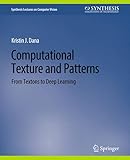Computational Texture and Patterns [electronic resource] : From Textons to Deep Learning / by Kristin J. Dana.
By: Dana, Kristin J [author.] .
.
Contributor(s): SpringerLink (Online service) .
.
Material type:  BookSeries: Synthesis Lectures on Computer Vision: Publisher: Cham : Springer International Publishing : Imprint: Springer, 2018Edition: 1st ed. 2018.Description: XIII, 99 p. online resource.Content type: text Media type: computer Carrier type: online resourceISBN: 9783031018237.Subject(s): Image processing -- Digital techniques
BookSeries: Synthesis Lectures on Computer Vision: Publisher: Cham : Springer International Publishing : Imprint: Springer, 2018Edition: 1st ed. 2018.Description: XIII, 99 p. online resource.Content type: text Media type: computer Carrier type: online resourceISBN: 9783031018237.Subject(s): Image processing -- Digital techniquesPreface -- Acknowledgments -- Visual Patterns and Texture -- Textons in Human and Computer Vision -- Texture Recognition -- Texture Segmentation -- Texture Synthesis -- Texture Style Transfer -- Return of the Pyramids -- Open Issues in Understanding Visual Patterns -- Applications for Texture and Patterns -- Tools for Mining Patterns: Cloud Services and Software Libraries -- Bibliography -- Author's Biography.
Visual pattern analysis is a fundamental tool in mining data for knowledge. Computational representations for patterns and texture allow us to summarize, store, compare, and label in order to learn about the physical world. Our ability to capture visual imagery with cameras and sensors has resulted in vast amounts of raw data, but using this information effectively in a task-specific manner requires sophisticated computational representations. We enumerate specific desirable traits for these representations: (1) intraclass invariance-to support recognition; (2) illumination and geometric invariance for robustness to imaging conditions; (3) support for prediction and synthesis to use the model to infer continuation of the pattern; (4) support for change detection to detect anomalies and perturbations; and (5) support for physics-based interpretation to infer system properties from appearance. In recent years, computer vision has undergone a metamorphosis with classic algorithms adaptingto new trends in deep learning. This text provides a tour of algorithm evolution including pattern recognition, segmentation and synthesis. We consider the general relevance and prominence of visual pattern analysis and applications that rely on computational models.


There are no comments for this item.